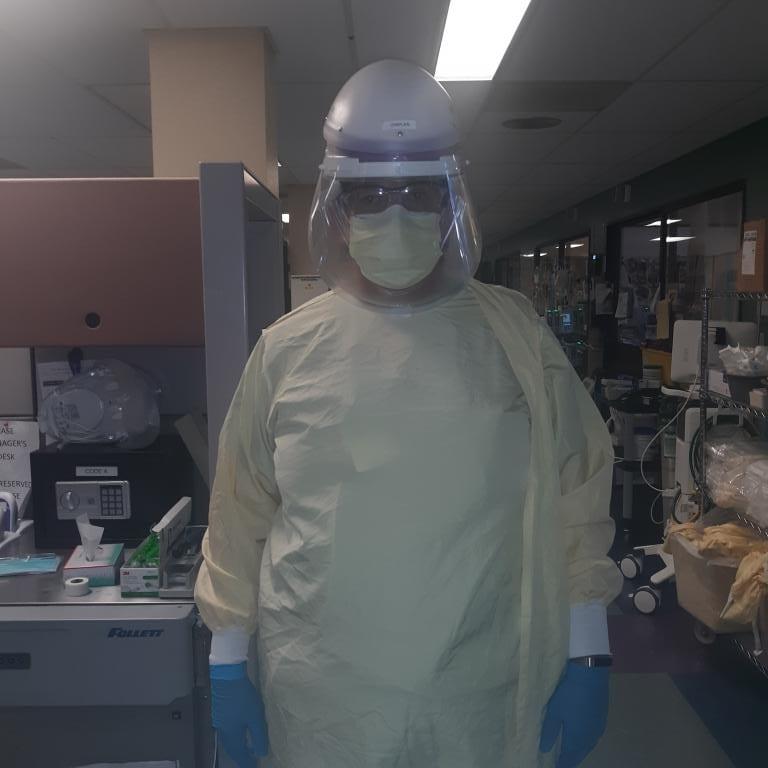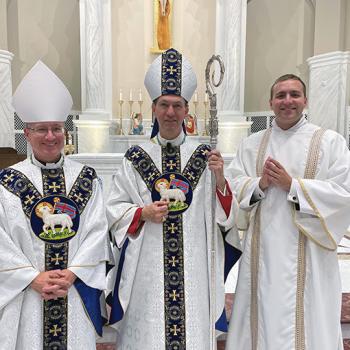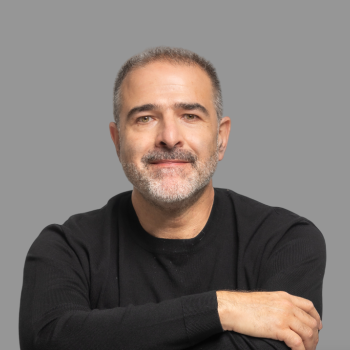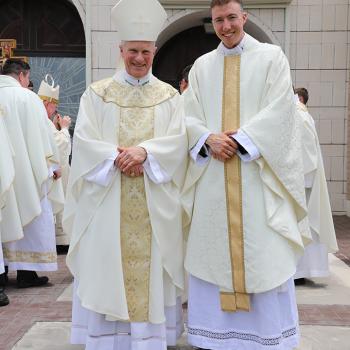Patient number 4 tells me they did not want to see a chaplain. It must have been their spouse that requested it. They were a COVID-19 patient. So I spent five minutes getting ready to see the patient for a five-minute conversation about them not requesting or wanting a chaplain. Then another 5 minutes to decontaminate and leave. 15 minutes.
Preparing To Enter A COVID Room
Arriving at the room of patient 5, I do the PPE dance one more time. preparing to enter the COVID-19 room. This patient just wants a rosary, communion and to know when Mass is in the hospital.
I hand them a rosary and explain that under the COVID-19 precautions the distribution of Holy Communion has been suspended indefinitely in the hospital. Also since this is not a religious hospital, and there is no priest on staff, there is no Mass offered in the hospital, let alone that it would have been suspended under the COVID-19 precautions anyway.

The patient then proceeds to explain Catholic Theology to me as it is apparent to them that I must not be Catholic and know nothing of the importance of Holy Communion and Mass. I allow the person to express their viewpoint reminding myself that by allowing them to vent, they may be a calmer patient overall.
As we wind up the 15-minute visit, I offer the patient a blessing and remind them of God’s un-ending love for them. I leave the room and repeat the decontamination drill.
Patient Going To Surgery
As I scan the list of remaining patients, I discover that patient #6 is now on their way to be prepared for surgery. Five minutes later I arrive at the pre-op ward, find the Lutheran patient on the board and go to the room to meet a person my age, obviously nervous, wide eyed and scared.
Of their many years they have never had this kind of surgery before. We talk of God’s care, pray for the surgeon’s skill, and for a quick and effective procedure. During my prayers, the prep nurse has started an IV and the anesthesiologist has arrived to meet the patient and get consents signed and provide an overview of their role.
I cannot leave. The patient has instinctively grasped my hand and is holding on with all their strength as the doctor talks. Finally, I invoke a blessing for them and leave to go find patient number 7.

A Spiritual Journey
Arriving at the room, I once again put on all the protective equipment in order to see the patient. A young person, no particular religious affiliation, stating a belief in God, but bounces around different faith traditions.
Raised Catholic, attended the Mormon Church, then tried Islam, currently attending both a Baptist church and a Jewish synagogue. It is clear to me that this person is on a spiritual journey.
We discuss various theologies and how they are different and where they are similar. I remind myself that my job is not to convince them of my faith but to help them find their faith. We talk for 20 minutes and once again my text alerts me to an emergency demanding a chaplain.
I explain the situation, offer my apologies and provide them some community contacts for follow up once they are discharged. I hurriedly remove the protective equipment, decontaminate and head off to the Code. My partner has already arrived and has the situation in hand. I turn back to my list. Patient 8.
COVID Strikes Again
Five minutes putting on the gear again. The nurse tells me what he knows as I get ready. The patient has congestive heart failure and is declining slowly. The COVID-19 virus has attacked their weakened heart and breathing is difficult.
I enter the room, and once again introduce myself and my role. Slowly and deliberately, we discuss the fear, the feeling of abandonment, and the terror of dying. “Have you ever read Psalm 22” I ask. No, they haven’t. I have a reflection on Psalm 22 (among other Psalms) and this seems like the time to share it.
It was an exercise I was given when I had these same feelings and fears 10 years ago as I battled stage 4 esophageal cancer. Over the last 10 years I reshaped the exercise into a 10-minute reflection to help me and others find the way when it seems there is no path, no light and no love to guide.
I am willing to bet you are more familiar with Psalm 22 than you might think. “My God, my God, why have you abandoned me?” is the first verse. The same cry from the human lips of Jesus on the Cross give us hope that our own feelings of desolation are not without hope.

Final Farewell
As I prepare to see patient #9, I have a glimmer of hope that I will be able to get all my patient requests seen today. But then my intra-hospital pager crackles to life asking for me to come to another room of another dying patient. Another COVID-19 patient.
Another family standing outside the window of the ICU room, watching, unable to hold the hand of their brother, father, child. Another Catholic. I silently say a prayer as I put on each piece of gear, getting ready to enter the room and be the family proxy.
As I enter the room after putting on all the gear again, I look into the face of a patient I saw last week and prayed with as they described their hopes and plans after “beating this thing”. I look through the mask of my protective helmet feeding filtered fresh air to me, out the window to see 6 weeping family members.
Pressing the call button on my intra-hospital pager, I summon my partner to meet with the family outside of the window. My partner is not Catholic, but you would not be able to tell it when she prays a Hail Mary with a patient. After she arrives outside with the family, I turn to the patient, I open my prayer book and begin Psalm 25 – “To you O Lord, I lift up my soul…..”
End Of The Day
5:00:
I am finally back in the office. I did not get to all my patient requests today. As I take my clothes off the back of the door and change to go home, I offer a prayer that those I could not see today will be there tomorrow when I walk back through the door.
Why Enter A COVID Room?
Some may ask why I enter a COVID-19 room instead of making a call to their room phone or their cell phone. There are two reasons: from experience I have found the far majority of the patients have difficulty talking on the phone because they have oxygen masks on or other breathing support equipment. The second reason is to help alleviate the emotions that go along with strict isolation in this environment.
Through the use of all the appropriate Personal Protective Equipment (PPE) and the Grace of God, I have never contracted the virus myself, in spite of being quarantined 4 times. In December 2020, I received the first vaccination shot and in January 2021 received the second shot. The change of clothing is to minimize the chance that I will take the virus home to my wife.
About Our Guest Blogger
Deacon Andy Corder is a Deacon in the Diocese of Tucson. He is a hospital chaplain in one of the largest hospitals in Tucson, AZ. This is part three of a reflection that will be presented in three parts.
You can read part one here and part two here.













